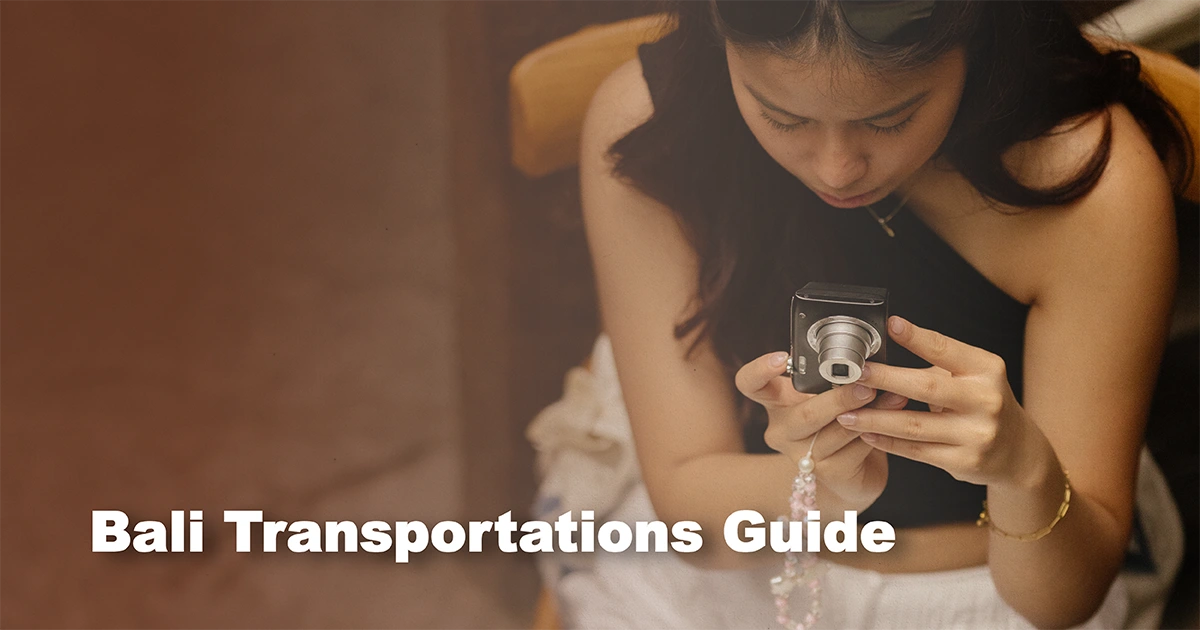When planning a trip to Bali, one of the key factors to consider is how you’ll move around the island. Bali offers a variety of transportation options, from motorbikes weaving through narrow alleys to air-conditioned private cars. Knowing the available transportation methods and which ones suit your travel style will make your trip smoother and more enjoyable. This guide explores all your options, including costs, convenience, and what to expect when traveling across Bali.
1. Ngurah Rai International Airport (DPS): The Gateway to Bali
Most travelers arrive in Bali through Ngurah Rai International Airport in Denpasar. From the airport, your transportation choices include airport taxis, private transfers, and ride-hailing apps.
- Airport Taxis: There are official taxis available at the airport, with fares fixed depending on the destination. You can book one from a designated counter to avoid overcharging.
- Private Transfers: Many hotels offer private pick-up services. This can be a more convenient but pricier option if you prefer a hassle-free transfer.
- Ride-Hailing Apps: Apps like Grab and Gojek operate in Bali. However, some areas have local taxi restrictions, so availability might vary.
2. Taxis: For Convenience in Tourist Areas
In popular areas like Kuta, Seminyak, and Ubud, metered taxis are common. Bluebird taxis are the most reliable since they use meters and offer a transparent pricing system. However, in some touristy zones, you may encounter drivers who prefer negotiating fixed fares instead of using the meter.
- Pros: Taxis are comfortable, air-conditioned, and ideal for short trips.
- Cons: Not always easy to find outside main tourist areas, and drivers may refuse meter use in some spots.
3. Ride-Hailing Apps: Affordable and Easy-to-Use
Grab and Gojek are Bali’s main ride-hailing apps, offering both motorbike and car options. They provide convenience and competitive pricing, especially for shorter trips.
- GrabBike and GoRide: For solo travelers, bike taxis are an affordable way to avoid traffic.
- GrabCar and GoCar: If you’re traveling with a group or have luggage, these app-based car rides are a convenient choice.
- Delivery Services: Both apps also offer food and grocery delivery, which is helpful if you need a quick meal at your accommodation.
It’s worth noting that ride-hailing services are sometimes restricted in places like Ubud or Canggu due to local taxi unions. In such cases, you may need to rely on local drivers or hotel shuttles.
Read more: 9 Unique Things You Will Only Find in Bali and Nowhere Else
4. Renting a Scooter: Popular Choice for Adventurous Travelers
Renting a scooter or motorbike is one of the most popular ways to explore Bali, offering flexibility and a sense of adventure. Scooter rentals are affordable, usually costing around IDR 80,000 to 150,000 per day (approximately USD 5 to 8).
- Requirements: You’ll need an international driver’s license to rent and legally operate a scooter in Bali.
- Safety Tips: Always wear a helmet and ride cautiously, as traffic can be chaotic in some areas.
- Fuel: Gas stations are common, but you can also find small roadside stalls selling petrol in bottles, usually for around IDR 10,000 per liter.
Renting a motorbike allows easy access to places like waterfalls, beaches, and rice terraces. However, this option is best suited for confident drivers due to unpredictable traffic conditions.
5. Private Drivers: Flexibility and Comfort for Long Distances
If you prefer comfort, hiring a private driver for a day is a great option, especially if you’re planning to visit multiple attractions spread across the island.
- Daily Rates: Prices for a private driver typically range between IDR 500,000 to 800,000 (USD 30 to 50) for a full day, including fuel.
- Advantages: Drivers often act as informal guides, offering insights about the places you visit.
- Where to Book: You can arrange private drivers through hotels, tour agencies, or online platforms like Klook.
This option is ideal if you’re traveling with family or in a group, as the cost can be shared.
Read more: What to Pack for Bali? Preparing for Unforgettable Journey
7. Shuttle Buses: Convenient for Intercity Travel
If you’re planning to travel between major tourist hubs, shuttle buses offer a comfortable and affordable solution. Companies like Perama Tour operate shuttles between popular destinations such as Ubud, Kuta, Sanur, and Lovina.
- Tickets: Shuttle bus tickets range from IDR 75,000 to 150,000 (USD 5 to 10), depending on the route.
- Convenience: Shuttles usually operate on set schedules, and you’ll need to book in advance.
This option is more budget-friendly than hiring a private driver for long distances, though it’s less flexible since you need to follow the bus timetable and routes
8. Public Buses: Limited but Inexpensive
Public buses are not widely used by tourists in Bali, but they do exist called Teman Bus. Teman Bus is a public bus system that connects Denpasar, Ubud, and other nearby areas.
- Cost: Fares are inexpensive, ranging from IDR 3,500 to 7,000 (around USD 0.25 to 0.50).
- Challenges: The buses can be slow, with limited routes and inconsistent schedules, making them less convenient for most travelers.
9. Bicycles: Eco-Friendly Option for Leisurely Exploration
For those staying in quieter areas like Ubud or Nusa Lembongan, renting a bicycle is a pleasant way to explore the surroundings. Many guesthouses and resorts offer bike rentals for around IDR 30,000 to 50,000 per day (USD 2 to 3).
- Ideal Areas: Biking is most enjoyable in scenic areas with light traffic, such as Ubud’s rice paddies or coastal paths on the islands.
- Caution: Cycling in busier areas like Kuta can be challenging due to traffic.
Read more: 7 Ways You Can Be More Eco-Friendly While In Bali
10. Boats and Ferries: Island Hopping Adventures
Bali serves as a gateway to several nearby islands, including Nusa Penida, Nusa Lembongan, and the Gili Islands. Speedboats and ferries operate regularly from Sanur, Padang Bai, and other ports.
- Prices: A one-way ticket to Nusa Penida or Lembongan typically costs around IDR 150,000 to 250,000 (USD 10 to 16).
- Where to Book: Tickets can be booked online, through travel agents, or directly at the harbor.
Island-hopping is a popular activity, and some tours offer packages that include transport and activities like snorkeling or diving.
11. What to Expect from Bali’s Traffic
Traffic in Bali, especially around Denpasar, Kuta, and Seminyak, can get congested during peak hours. Roads are often narrow, and driving habits may seem chaotic to first-time visitors. If you’re renting a vehicle or motorbike, it’s essential to stay calm, drive defensively, and be aware of motorbikes and pedestrians at all times.
12. Tips for Choosing the Right Transportation
Distance: For short distances, ride-hailing apps or taxis are most convenient. For longer trips, private drivers or shuttles are better options.
- Traffic Conditions: Consider renting a motorbike if you want to avoid traffic jams.
- Group Size: Traveling with a group? A private car or shuttle bus will be more comfortable and cost-effective.
- Local Etiquette: Be patient and polite with drivers. A small tip (around IDR 10,000 to 20,000) is appreciated but not mandatory.
Bali offers diverse transportation options, each catering to different preferences and travel styles. Whether you’re seeking the freedom of a scooter, the comfort of a private car, or the affordability of ride-hailing services, the island has you covered. By planning your transportation ahead of time and staying flexible, you can explore Bali’s breathtaking landscapes and vibrant culture at your own pace.
5 Frequently Asked Questions about Bali Transportation
1. Can I rent a car and drive myself around Bali?
Yes, you can rent a car in Bali, either with or without a driver. Self-driving offers flexibility, but you’ll need an international driving license to legally drive. Traffic in Bali can be chaotic, especially in busy areas like Kuta or Denpasar, so it’s best suited for experienced drivers. Also, parking can be limited in tourist hotspots.
2. Is it safe to use ride-hailing apps like Grab and Gojek everywhere?
While Grab and Gojek operate in many parts of Bali, some areas restrict their services due to local taxi unions. In regions like Ubud, Canggu, or Sanur, you might face difficulties booking rides. However, you can often arrange rides discreetly by asking your hotel or finding pickup points outside restricted zones.
3. What is the best way to travel between Bali’s beaches and temples?
If you plan to visit multiple attractions like beaches and temples in a single day, hiring a private driver is the most convenient option. Alternatively, shuttle services connect major tourist areas, but they follow set schedules. Renting a motorbike is another option, especially if you’re comfortable navigating Bali’s traffic.
4. How do I get from Bali to the Gili Islands or Nusa Penida?
Fast boats and ferries operate from Sanur, Padang Bai, and Serangan ports to nearby islands like the Gili Islands and Nusa Penida. It’s recommended to book tickets in advance, especially during peak tourist seasons. Some tour packages offer island transport bundled with snorkeling or diving activities.
5. Do I need travel insurance if I rent a motorbike?
Yes, it’s highly recommended. Accidents involving motorbikes are not uncommon in Bali, so having travel insurance that covers motorbike accidents can save you from significant expenses. Make sure to read the policy carefully, as some insurance providers require you to have a valid motorbike license for coverage.










